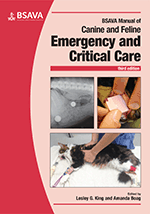
Full text loading...

Ocular emergencies can be intimidating and frustrating for veterinary surgeons (veterinarians). Many ophthalmological emergencies can be diagnosed and treated successfully with the basic equipment available to every veterinary surgeon. This chapter discusses the diagnosis, treatment and prognosis of common ophthalmological emergencies.
Ophthalmological emergencies, Page 1 of 1
< Previous page | Next page > /docserver/preview/fulltext/10.22233/9781910443262/9781910443262.10-1.gif

Full text loading...
























